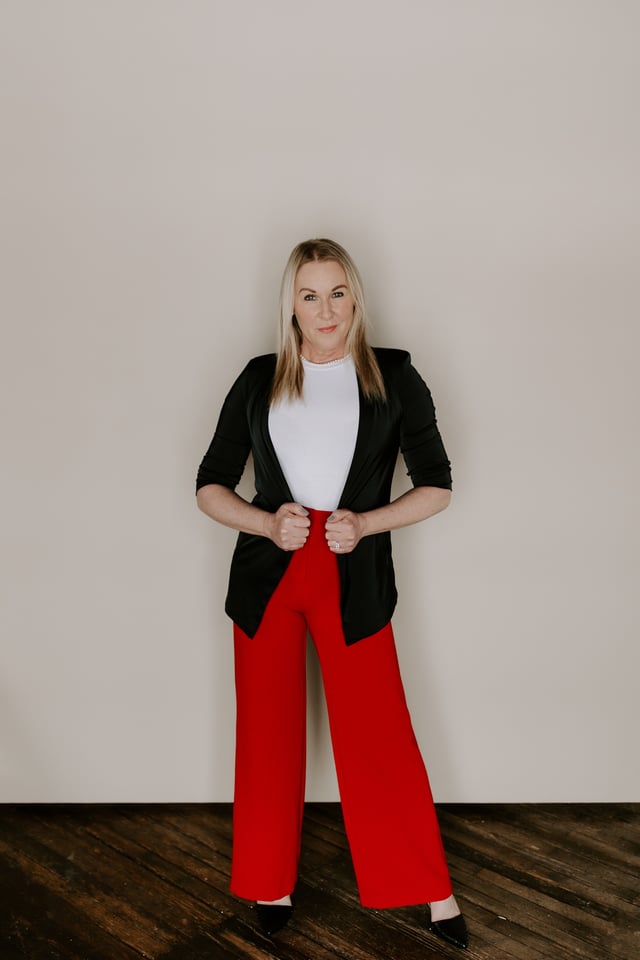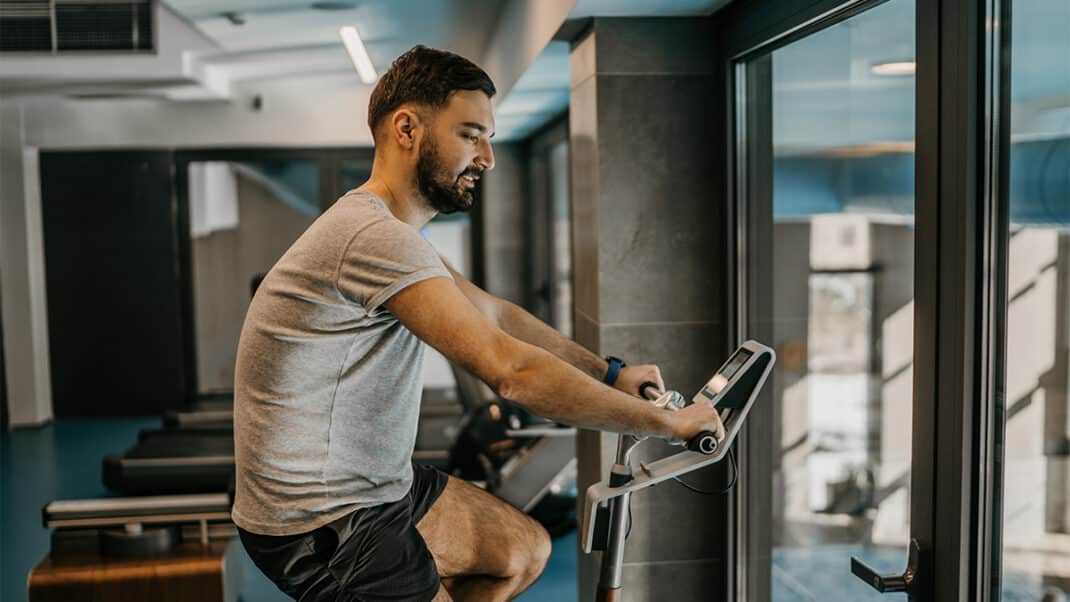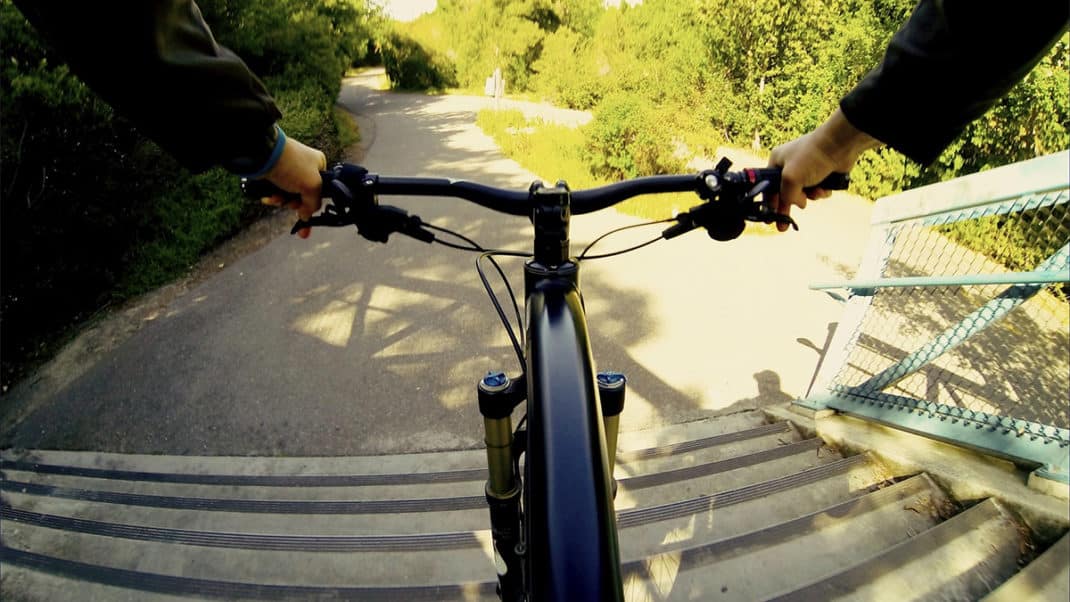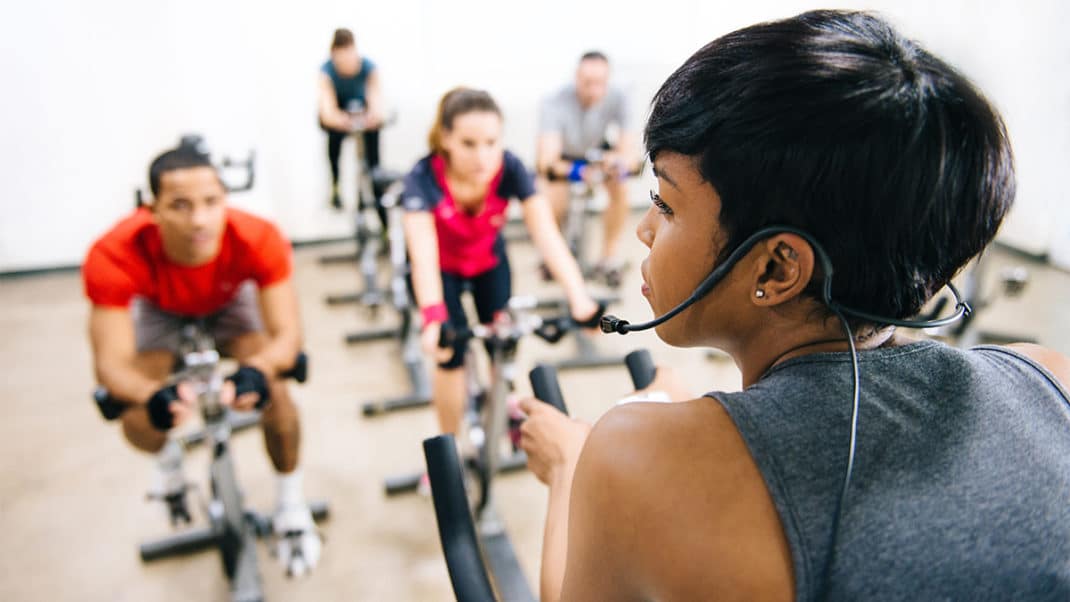Cycle Barre
Expand your class offerings with this fusion of cycling and barre.
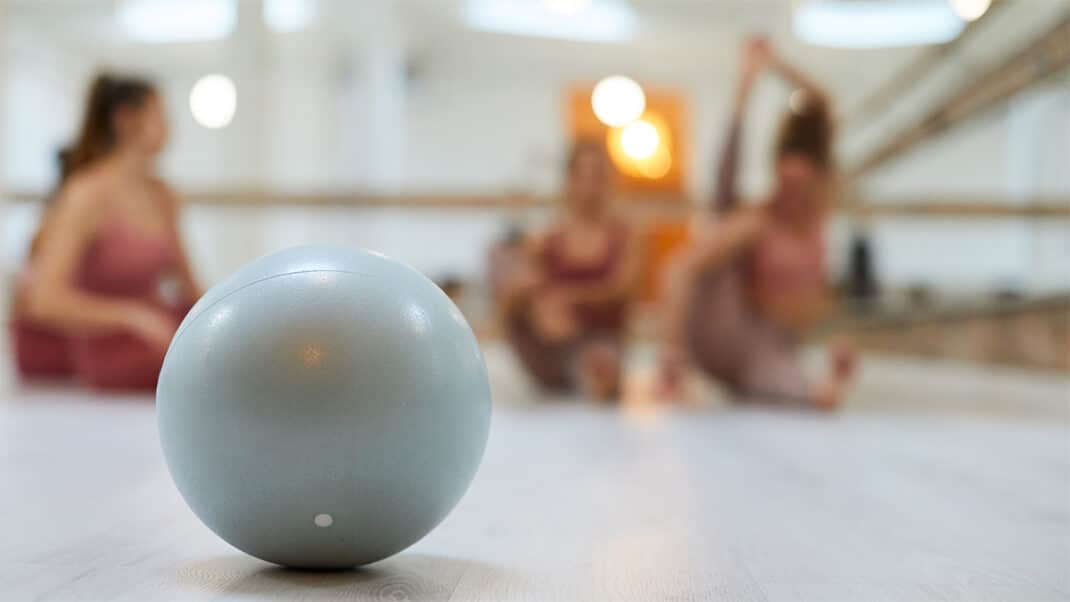
Are you looking to expand your fitness class offerings and deepen your knowledge of fresh and updated formats? Barre and cycling are both very accessible forms of exercise, with formats that are easy to start at any level of fitness. “The bike is a perfect replacement for a barre, so a fusion of cycle and barre equals a great workout and member satisfaction,” says Tricia Murphy-Madden, Director of Education at Savier Fitness, and creator of the Pedal and Pulse workshop by Schwinn.
According to Class Pass’s 2022 Fitness Trends Report, barre ranks 5th among the most popular workouts of 2022. “Barre can be an excellent choice for fusing with cycling because they complement each other in muscle activation and planes of motion,” says Elizabeth Lenart, Director of University Fitness at Yale University.
One Plié at a Time
Most of what is done in a traditional barre class today comes from the work of Lotte Berk, the originator of Barre. You may imagine dancers standing in formation around a ballet barre, but stereotypes like these can make attending a barre class intimidating. “Barre consists of ballet foot and arm positions, Pilates, strength and endurance training, posture exercises, mobility, and flexibility, so it’s not really ballet, but bodyweight exercises targeting major muscle groups, posture and alignment,” says Abbie Appel, owner of Abbie Fit Consulting and a Schwinn Indoor Cycling Master Trainer. “It’s easy to fuse these formats to create an intense workout with variety in the muscle conditioning which is important because cycling is so linear,” says Appel.
New Format = Everyone Happy
Lenart started her cycle barre combination format with mixed reactions from her students. “Most of my participants had never taken one cycling class before they tried the cycle barre format, so they were intimidated by the bikes. For my cycling crowd, they stuck their nose in the air because they thought barre was too easy. So Lenart created a class called “Biker Barre” where we rock out to great music for the cycling intervals, then we get off the bike to open the body, stretch, and strengthen the posterior chain,” says Lenart.
The Benefits of Fusing a Cycle & Barre Workout
Wondering if you should give combination or fusion classes like cycle barre a try? Consider the following benefits to adding this format to your club’s group fitness offerings:
It’s Low Impact
For clients who live with arthritis, are recovering from injury, pregnant or postpartum, combining the low-impact nature of cycling with barre’s endurance based postural training makes it a great cardio and endurance workout that appeals.
Shorter Class Formats Attracts Different Demographics
According to Schwinn Master Trainer Doris Thews, shorter classes are what consumers want post-COVID. If you expose members to new classes they would not normally consider attending, they can just sample the format. “It’s a short duration combination format which allows individuals to make a shorter commitment to each, which is better for a member who comes to try a new format, and this is great for growing your group fitness program without changing your payroll budget,” says Thews.
Indoor Cycling with Barre Improves Posture
Drawbacks to cycling can include a loss of lateral motion by placing a focus on the front of the body when “there is often an imbalance in posterior strength,” says Lenart. By ensuring class participants are maintaining a “plank” posture while riding (alignment in the angle of the ear, shoulder, hip, knee, ankle and scapular retraction), Lenart ensures that participants can learn to avoid holding themselves in positions that might cause pain and promote poor posture.
Multi Planar Training
“The variety of planar working positions is a huge benefit of adding barre to cycling because it decreases the risk of overuse injuries, enhances muscular balance in underutilized muscle groups, and decreases the risk of adverse postural concerns,” says Appel. The coupling of barre, using its multi-planar approach, with sagittal plane-dominant cycling, can shift the body into a variety of planes of motion. By branching out from the strict sagittal plane of cycling, the cohesive addition of barre can enhance the body’s ability to perform daily movements better and pain free.
See also: Sample Class: Barre Fight
Sample Class Format: Power Programming Cycle Barre
Equipment: Dumbbells (a lighter and heavier set), a Bender Ball, gliding discs, a loop band, tubing, a mat, the bike.
Class Duration: ~50-minutes
Cycle Heat Up: a 4-minute endurance interval on the cycle. Easy resistance with controlled pedaling. Offer participants 1, 2, 3-minute cues, and follow up with the final minute, decreasing speed and exiting the cycle.
Barre Heat Up: Move to the mat and perform the following movements to further prepare the body for this combination cardio and joint-strength focused workout.
Quadruped Cat/Cow 3-4x
Spinal Balance with Opposite Arm Reaches 4x each R & L
Plank to Downward Facing Dog to a Triceps Push Up 4x total.
Kneeling to a Runner’s Lunge to a Knee Extension Switch 4x each R & L
Barre Round #1
This 5-minute time-based interval consists of 30 seconds work/10 second transitions. Perform each set 3 times.
Facing Bike – Barre S/L Hip Hinge w/Knee Flexion w/Bender Ball (Figures 1a and 1b) to a Curtsey Lunge R & L
Facing Bike – Bender Ball Squat to a Stand to a Heel Raise (Figure 1c)


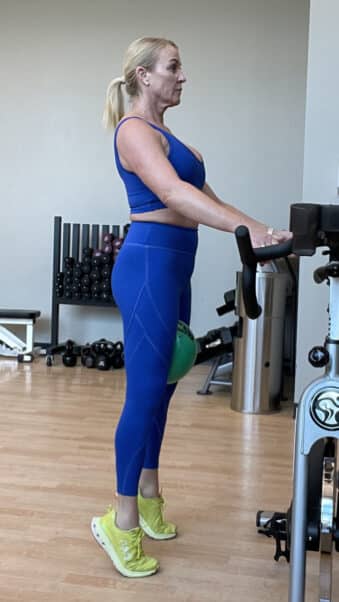
Cycle Round #1
4-minutes, Tabata-style interval
Select tension that allows the rider to feel the resistance without compromising their ideal RPM and their ability to still feel the resistance of the bike. Power through the 20-seconds, then allow 10-seconds to pedal at whatever pace feels like recovery. Repeat 8 times with 20-seconds of work coupled with 10-seconds of active recovery. Stay seated.
Barre Round #2
Rep-based movements in the sagittal plane facing the barre. A Gliding Disc under each foot, hinge and stabilize on the barre (Figures 2a, 2b and 2c).
GD Runner’s Lunge Full ROM 8x, ½ ROM 8x, Pulse ROM 8x Hold 8x R
GD Runner’s Lunge Full ROM 8x, ½ ROM 8x, Pulse ROM 8x Hold 8x L

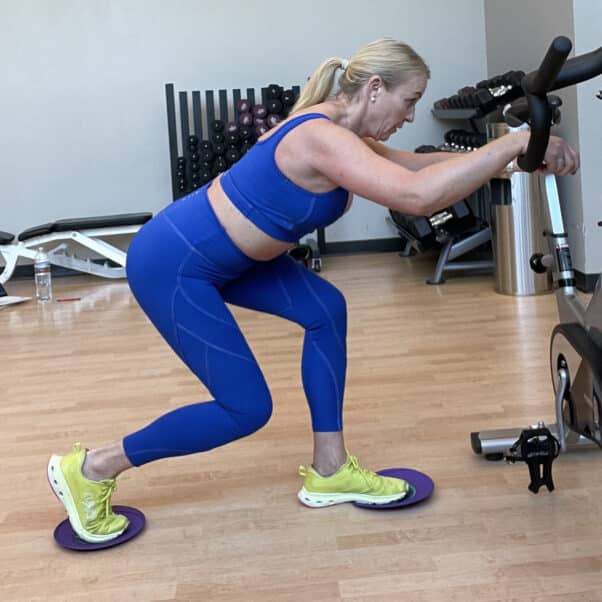
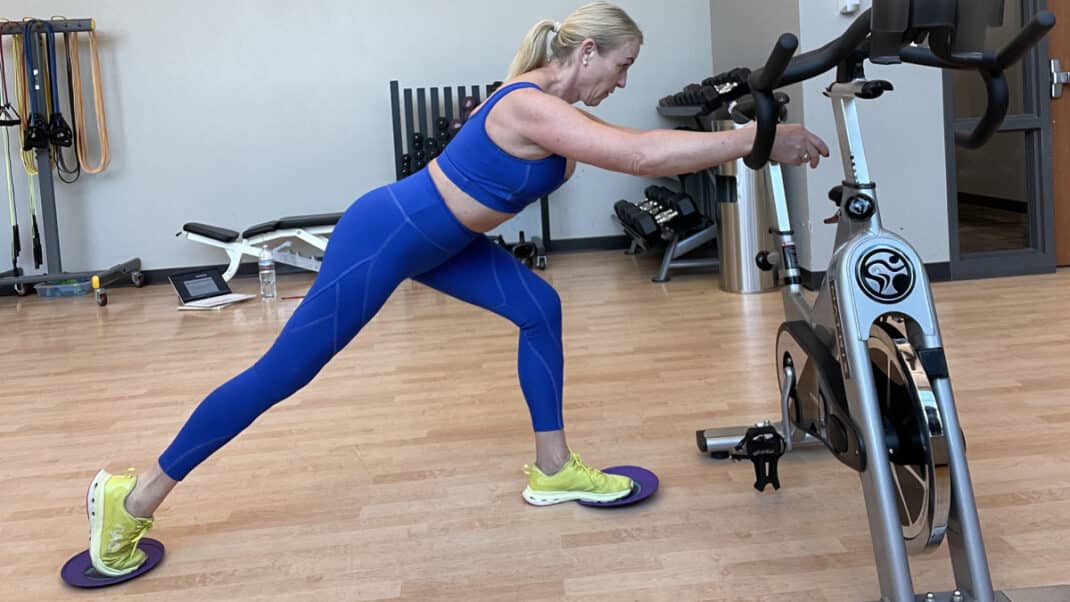
Cycle Round #2
6-minutes, progressive 1-minute intervals. Clients increase pedal resistance each minute while also trying to maintain a consistent power output. Standing climb for last minute. Stop at 4-minutes and exit the cycle.
Barre Round #3
Start by standing sideways to the bike in a plié stance, with a Gliding Disk under each foot (Figure 3a). Lower into the plié squat (Figure 3b), and as you rise turn the back foot towards the bike and reach the arm to face the bike (Figure 3c) to perform a lunge (Figure 3d). Return to plié stance. Add range of motion and tempo variations.
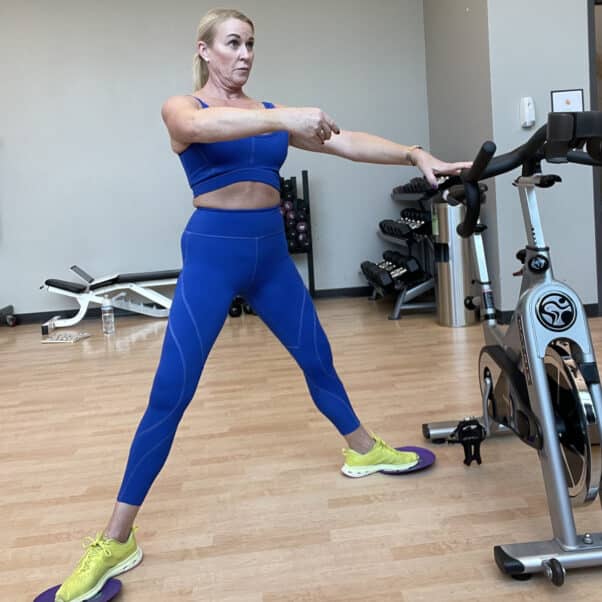

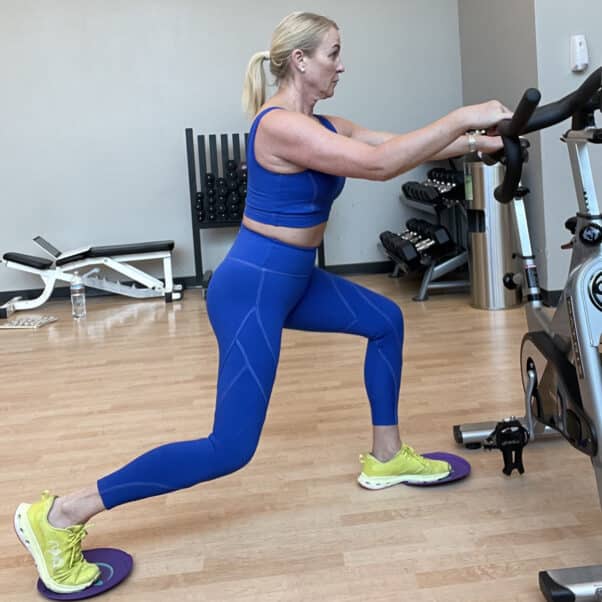

Cycle Round #3
6-minute hard/recovery. Ask clients to increase pedal speed against resistance for 1 minute, then recover for 1 minute while also trying to maintain a consistent power output. Standing climb for the last minute. Stop at 6-minutes and exit the cycle.
The Barre Life
With education so easy to gain access to, getting up to speed on the combination of cycling with portable fitness tools barre classes can offer members and clients a constantly evolving and renewed fitness class format, so that each experience feels fresh, fun, and super effective. Education and training in these areas of fitness is easy to find. Several reputable fitness instructor training programs exist that can help you to learn how to combine these two formats safely and effectively for a unique new class experience.
See also: Sample Class: Barre-Cardio-Core
Irene McCormick, MS
"Irene McCormick, MS, is the 2018 IDEA Instructor of the Year and the senior director of fitness education for Orangetheory Fitness® in Boca Raton, Florida. Former adjunct faculty at Drake University, Irene is a master course instructor for TRX®, a lead conference educator for WaterRower®, a Savvier Fitness master trainer, a Ryka® brand ambassador and an award-winning conference educator. She has also written two books, and is a subject matter expert for ACE, NASM, Human Kinetics and Orangetheory."
